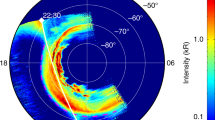Abstract
Ionospheric conductivity is not very easily measured directly. Incoherent scatter radars perhaps offer the best method but can only measure at one point in the sky at any one time and are limited in their time resolution. Statistical models of average conductivity are available but these may not be applied to individual case studies such as substorms. There are many instances where a real-time estimate of ionospheric conductivity over a large field-of-view is highly desirable at a high temporal and spatial resolution. We show that it is possible to make a reasonable estimate of the noctural height-integrated Pedersen conductivity, or conductance, with a single all-sky TV camera operating at 557.7 nm. This is not so in the case of the Hall conductance where at least two auroral wavelengths should be imaged in order to estimate additionally the energy of the precipitating particles.
Similar content being viewed by others
Author information
Authors and Affiliations
About this article
Cite this article
Kosch, M.J., Hagfors, T. & Schlegel, K. Extrapolating EISCAT Pedersen conductances to other parts of the sky using ground-based TV auroral images. Annales Geophysicae 16, 583–588 (1998). https://doi.org/10.1007/s00585-998-0583-y
Received:
Revised:
Accepted:
Issue Date:
DOI: https://doi.org/10.1007/s00585-998-0583-y




